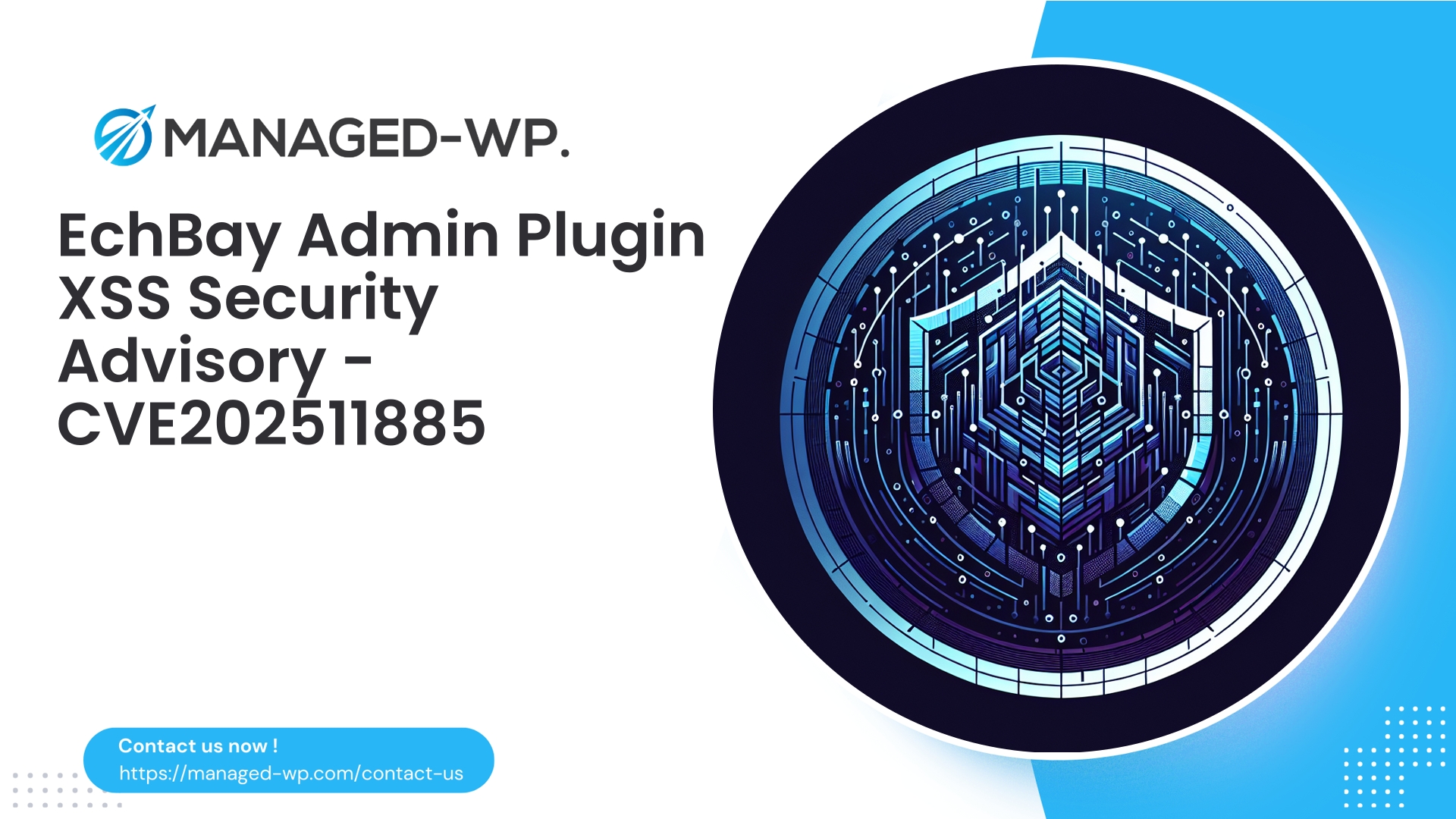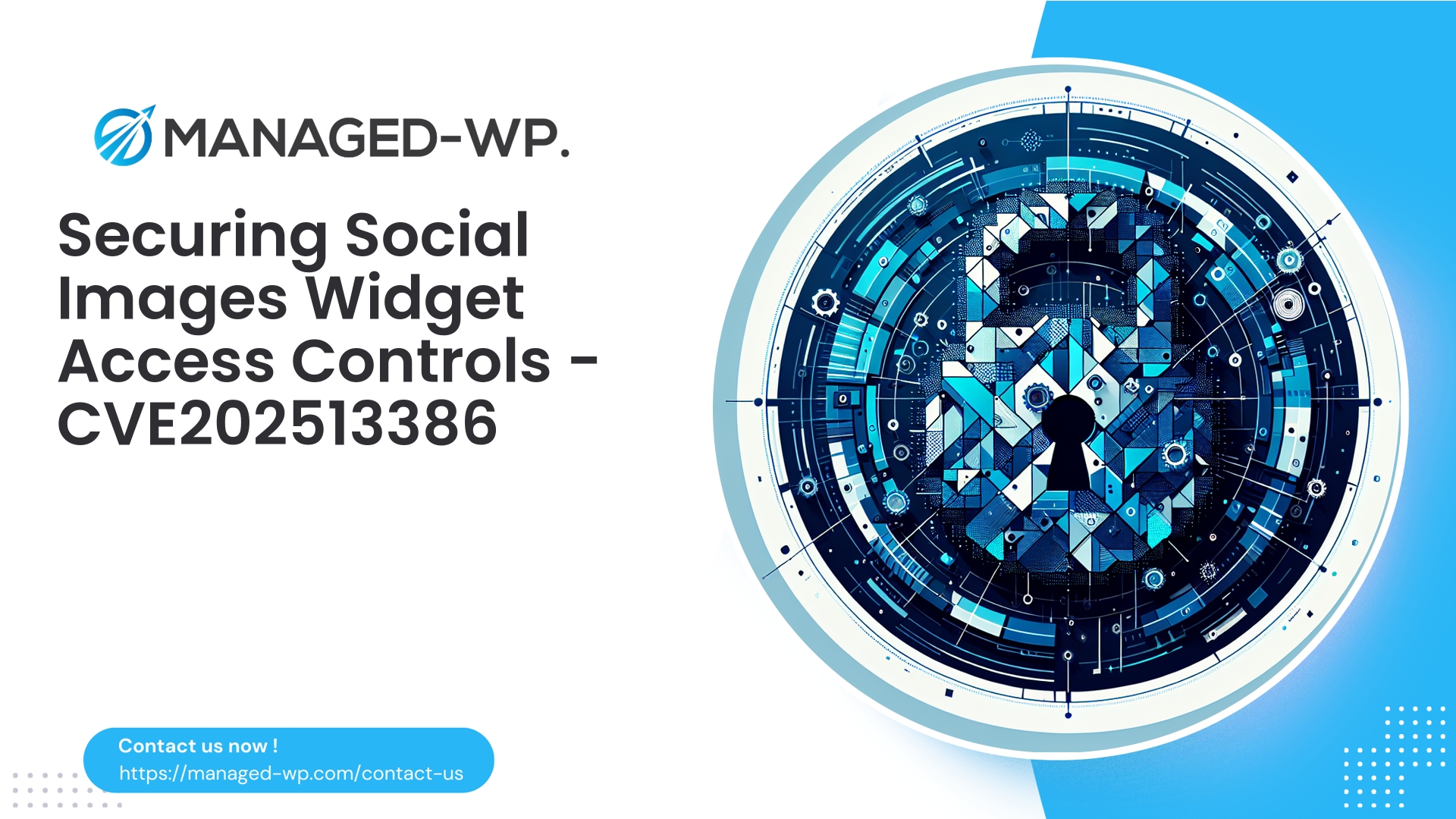| Plugin Name | Autochat Automatic Conversation |
|---|---|
| Type of Vulnerability | Broken Access Control |
| CVE Number | CVE-2025-12043 |
| Urgency | Low |
| CVE Publish Date | 2025-11-24 |
| Source URL | CVE-2025-12043 |
Critical Alert: Broken Access Control in Autochat — Automatic Conversation Plugin (≤ 1.1.9) — Immediate Steps for WordPress Administrators
Executive Summary
- Vulnerability Identified: Broken Access Control — allows unauthenticated modification of plugin settings
- Affected Plugin: Autochat — Automatic Conversation (versions 1.1.9 and earlier)
- Official Identifier: CVE-2025-12043
- Severity Score: CVSS 5.3 (Medium; patch priority considered Low but contextual risk high)
- Disclosure Date: November 25, 2025
- Privilege Required: None (exploitable without authentication)
- Available Fix: Not yet released by vendor
As cybersecurity specialists dedicated to WordPress protection at Managed-WP, we provide you an in-depth assessment of this unauthorized access vulnerability. This advisory elucidates the technical risks, practical detection techniques, and actionable mitigation strategies to safeguard your WordPress sites.
Why This Vulnerability Demands Attention Despite a Moderate Severity Rating
The core issue is a broken access control flaw that permits attackers without authentication to alter crucial plugin settings. Plugin configurations often govern sensitive functions including API integrations, automated chat behaviors, redirects, and external webhooks.
While not directly enabling remote code execution, the unauthorized ability to modify these options can facilitate:
- Redirection of users to malicious or phishing domains
- Alteration of bot responses to disseminate spam or misleading content
- Concealment of unauthorized activities through log manipulation
- Exposure or misuse of sensitive API keys and webhook URLs
- Establishment of persistence footholds to escalate attacks later
Consequently, trivial-seeming access failures can escalate into detrimental business and reputation impacts. Vigilance is paramount.
Typical Causes Behind Broken Access Control in WordPress Plugins
The vulnerability class frequently results from developer oversights such as:
- Omission of capability checks (e.g., failure to verify
current_user_can('manage_options')) - Lack of nonce verification to block Cross-Site Request Forgery (CSRF) attacks
- Public REST API or AJAX endpoints accepting write operations without authentication
- Relying solely on security through obscurity instead of explicit authorization enforcement
- Exposing admin-only AJAX actions or plugin endpoints to unauthenticated users
Due to WordPress’s multiple input vectors, meticulous authorization validation is non-negotiable for any persistent data modification.
Implications of the Autochat Vulnerability at a Glance
- Enables unauthenticated attackers to update plugin settings
- No WordPress login or credentials needed to exploit
- Changes are saved persistently in the database affecting ongoing plugin operation
- Exploitation is straightforward; attackers only need to craft simple HTTP POST requests
While explicit proof-of-concept exploits are omitted for security reasons, the risk these implications pose should drive immediate protective action.
Action Plan for WordPress Site Owners and Administrators
- Identify
- Locate all WordPress installations running Autochat Automatic Conversation.
- Confirm plugin versions; if ≤ 1.1.9, classify as vulnerable.
- Contain
- If feasible, deactivate the plugin within WordPress or rename plugin folder via FTP/SFTP (
wp-content/plugins/autochat-for-wptoautochat-for-wp.disabled). - If not possible, implement site-level restrictions (e.g., maintenance mode, IP allowlisting) to control inbound traffic.
- If feasible, deactivate the plugin within WordPress or rename plugin folder via FTP/SFTP (
- Perimeter Defense
- Configure Web Application Firewall (WAF) rules to block unauthenticated POST requests targeting the vulnerable plugin’s endpoints.
- Implement rate limits on admin-ajax and REST API POST requests for added protection.
- Monitor and Revert
- Audit the
wp_optionstable for unauthorized changes including unknown URLs or keys. - Restore settings from a known good backup if anomalies are detected.
- Audit the
- Secure Credentials
- Rotate all API keys, webhook secrets, and related credentials potentially impacted.
- Update WordPress admin and affiliated credentials to strong, unique passwords.
- Patch
- Apply official plugin updates promptly upon release.
- Absent a fix, evaluate replacing the plugin with a secure alternative.
Detecting Attempts and Indicators of Compromise
Examine the following for signs of exploitation:
- HTTP Logs: Suspicious POST requests to
admin-ajax.php, REST endpoints (/wp-json/), or plugin-specific URLs lacking authentication cookies or nonce tokens. - Audit Trails: Unexpected changes to plugin-related options in
wp_options. - File System: New or altered files in uploads or plugin directories.
- Database Entries: Unknown or suspicious configuration tokens, URLs, or keys.
- Outbound Traffic Logs: Unfamiliar external connections indicating data exfiltration or command and control.
Promptly implement incident response measures upon detection.
WAF Virtual Patching and Defensive Strategies
While awaiting official plugin fixes, deploying adaptive firewall rules is critical:
- Block unauthenticated POST requests to suspected plugin endpoints.
- Enforce valid WordPress nonce tokens on all settings updates.
- Rate-limit anonymous POST traffic to admin-ajax and admin-post endpoints.
- Filter suspicious payloads, such as external URLs or encoded strings, in setting parameters.
- Log and alert on suspected exploit attempts before enforcing full blocking.
- Restrict direct file access to plugin PHP files externally wherever possible.
Testing rule sets in staging environments before production rollout is recommended to avoid unintended disruptions.
Best Practice Hardening Beyond WAF
- Enforce least privilege user roles and require strong authentication mechanisms like two-factor authentication.
- Regularly remove unused plugins and themes to minimize attack surface.
- Ensure all WordPress core, plugins, themes, PHP, and server components are actively updated.
- Vet plugins rigorously before installation, including reputation, update cadence, and code reviews.
- Maintain and test robust backups stored externally.
- Enable logging and integrity monitoring of files and databases.
- Configure strict file and database permissions to prevent unauthorized modifications.
- Use staging environments for testing all updates and plugin installations prior to production deployment.
Incident Response Checklist
- Containment: Take site offline or place behind maintenance firewall; disable the vulnerable plugin immediately.
- Evidence Preservation: Preserve all relevant logs and take system snapshots.
- Assessment: Identify scope including modified settings, files, users, and network connections.
- Eradication: Remove or revert malicious files and content; reinstall clean plugins if necessary.
- Recovery: Restore verified backups and rotate all sensitive credentials.
- Post-Incident Review: Conduct root cause analysis; implement permanent mitigation and notify stakeholders.
If in-house expertise is limited, consider engaging Managed-WP’s professional incident response specialists.
Reality Check on CVSS Scores and Operational Risk
Although CVSS 5.3 suggests moderate impact, real-world consequences hinge on plugin use context:
- Sensitivity and scope of API/webhook integrations
- Plugin’s role in frontend behavior and user experience
- Site audience size and visibility influencing reputational stakes
- Networked sites sharing configurations or keys
A medium severity rating should never lull administrators into complacency when critical integrations or high-profile sites are concerned.
Communicating the Issue to Stakeholders
- Provide transparent explanations emphasizing that unauthorized modification of chat settings could harm users via spam or redirects.
- Detail steps already taken such as plugin deactivation, firewall rule application, and credential rotations.
- Outline next actions and timelines for updates, monitoring, and recovery verification.
How Managed-WP Provides Layered Protection
Managed-WP’s security approach delivers comprehensive defense:
- Proactive WAF rules blocking unauthorized configuration changes
- Virtual patching that rapidly stops exploit attempts independent of plugin updates
- Behavioral analytics detecting anomalies like sudden config changes or outbound traffic spikes
- Continuous malware scanning and incident response assistance
- Expert guidance informed by WordPress-specific threat intelligence
These layers ensure vulnerabilities due to missing plugin authorization checks are effectively compensated at the perimeter.
Try Managed-WP Basic Plan for Immediate Protection
For rapid deployment of enterprise-grade WordPress security, Managed-WP Basic offers:
- Essential managed firewall and WAF
- Unlimited bandwidth and malware scanning
- Mitigation against OWASP Top 10 risk vectors, including unauthorized settings modifications
Get started at no cost and shield your site today:
https://managed-wp.com/pricing
Recommended Timeline & Prioritization
- Immediate (Day 0): Identify vulnerable sites, disable the plugin or apply WAF blocks.
- Short Term (Days 1-3): Audit logs and databases, rotate credentials, and monitor for anomalies.
- Mid Term (Days 3-14): Deploy vendor patch once available, or plan safe plugin replacement.
- Ongoing: Maintain WAF rules, continuous monitoring, timely updates, and backups.
Frequently Asked Questions
Q: Is my site at risk if it doesn’t run Autochat Automatic Conversation?
A: No, if you don’t use this plugin or have updated past version 1.1.9, you are not vulnerable to this specific issue. However, the principles of vigilance and defense apply broadly across all plugins.
Q: What if I cannot deactivate the vulnerable plugin due to business needs?
A: In such cases, implement strict WAF protections, restrict administrative access to trusted IP addresses, and monitor all site traffic closely to mitigate exploitation risk.
Q: How can I tell if my site has already been compromised?
A: Indicators include unexpected changes to plugin settings, unauthorized admin users, suspicious outbound connections, suspicious file modifications, or abnormal POST requests in logs. When unsure, preserve evidence and consult a security professional.
Closing Remarks from a Managed-WP Security Expert
Broken access control vulnerabilities enabling unauthenticated configuration changes are stealthy yet potent threats. Although not immediately catastrophic, they open doors to persistent manipulation, data leaks, and reputational harm. The path forward demands swift containment, thorough forensic review, and permanent mitigation.
Managed perimeter defenses such as Managed-WP’s firewall solutions provide critical time and protection buffers while you address plugin vulnerabilities. Stay vigilant, maintain backups, and prioritize securing configuration modification points as stringently as file uploads and login paths.
Take Proactive Action — Secure Your Site with Managed-WP
Don’t risk your business or reputation due to overlooked plugin flaws or weak permissions. Managed-WP provides robust Web Application Firewall (WAF) protection, tailored vulnerability response, and hands-on remediation for WordPress security that goes far beyond standard hosting services.
Exclusive Offer for Blog Readers: Access our MWPv1r1 protection plan—industry-grade security starting from just USD20/month.
- Automated virtual patching and advanced role-based traffic filtering
- Personalized onboarding and step-by-step site security checklist
- Real-time monitoring, incident alerts, and priority remediation support
- Actionable best-practice guides for secrets management and role hardening
Get Started Easily — Secure Your Site for USD20/month:
Protect My Site with Managed-WP MWPv1r1 Plan
Why trust Managed-WP?
- Immediate coverage against newly discovered plugin and theme vulnerabilities
- Custom WAF rules and instant virtual patching for high-risk scenarios
- Concierge onboarding, expert remediation, and best-practice advice whenever you need it
Don’t wait for the next security breach. Safeguard your WordPress site and reputation with Managed-WP—the choice for businesses serious about security.
Click above to start your protection today (MWPv1r1 plan, USD20/month).



















